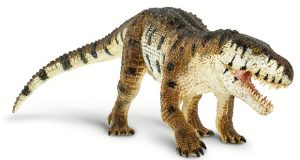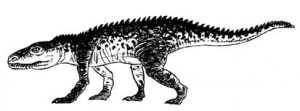Ancient Crocodile Ancestor Fossils Discovered in Brazil
The most complete fossil of an ancient member of the crocodile lineage of archosaurs, a crocodylotarsian has been discovered in Brazil.
The archosaurs, the group of reptiles that the dinosaurs and pterosaurs evolved from originated in the latter stages of the Palaeozoic. However, after the mass extinction that took place at the end of the Permian period this group rapidly diversified into many different forms to fill the vacant niches in the early Triassic ecosystem. The archosaurs essentially split into two main forms, the ornithodirans (dinosaurs, pterosaurs and Aves) and the crocodylotarsians – the crocodile-group reptiles.
Crocodylotarsian
One of the most successful of the crocodile-group of archosaurs were the rauisuchians. These animals were characterised by their long hind limbs and slightly shorter front legs that were positioned directly underneath their bodies. Many were deep skulled, large predators some of which were the apex predators of the Middle to Late Triassic and would have preyed upon the first dinosaurs. A number of genera are known with fossils of these creatures having been found in places as far apart as Europe and Argentina. However, it must be remembered that during this part of the Earth’s history, most of the continents were formed into a single giant land mass called Pangea.
One of the best known, large Triassic rauisuchian predators is Prestosuchus chiniquensis and a new specimen of this fierce meat-eater discovered this year is being heralded by scientists as the best preserved and most complete example of a large rauisuchian ever found.
A Replica of Prestosuchus
The image (above) shows a replica of Prestosuchus from a model range, see it at Everything Dinosaur’s website and other figures in this range: Safari Ltd. Wild Safari Prehistoric World.
Pictures show the fossil of the Prestosuchus and its matrix in the white plaster jacket ready for transport away from the dig site. The superbly preserved skull can be seen on the right of the picture in this almost fully articulated specimen. The large, curved teeth in the upper jaw are prominent, but surprisingly, the distinctive downward bend at the tip of the snout, a characteristic feature of this genus cannot easily be made out.
A Triassic Lakebed
The specimen was discovered by a team of Brazilian palaeontologists and field workers from the Lutheran University of Brazil, the fossil was discovered in rock strata that had once been an ancient Triassic lakebed some 238 million years ago. The excavation site is near to the town of Dona Francisca in the state of Rio Grande do Sul.
The specimen, one of the largest rauisuchian fossils ever discovered is over 7 metres long, far larger than other fossils of Prestosuchus chiniquensi excavated in the area. It is thought that this large creature would have weighed close to one Tonne. It probably died close to where the carcase was buried, if the body had been transported any distance after the animal died it is highly unlikely that the remains would have stayed as complete and in almost perfect articulation.
Commenting on the discovery, a spokesperson stated:
“It is something that we could never imagine, the quality of preservation and the size of the fossils are sensational.”
The scientists are hopeful that when the individual bones are extracted from the matrix in the preparation laboratory, it may give them the chance to learn more about the anatomy of these creatures. The well preserved hind leg (seen in the pictures, being carefully brushed by a researcher in the background), could help solve a mystery regarding rauisuchian locomotion. Some scientists have speculated that these animals were facultative bipeds – spending a large part of the time on four feet, but being capable of walking on their hind legs when required.
A spokesperson for Everything Dinosaur stated:
“A large predator such as Prestosuchus may have been capable of bipedal locomotion, raising itself onto its hind legs in order to pursue its prey of large vertebrates such as dicynodonts and rhynchosaurs.”
The Prestosuchus may have been a lake side resident, large enough to defend a prime hunting site from other smaller predators. As herds of herbivores came down to drink, the Prestosuchus may have ambushed them. The Brazilian team hope to complete their work on the fossil specimen in the next two years or so and when it is ready for display they are keen to see it sent to a Brazilian museum so the fossil can remain within the country.
An Illustration of a Rauisuchian
Picture credit: Everything Dinosaur








Leave A Comment